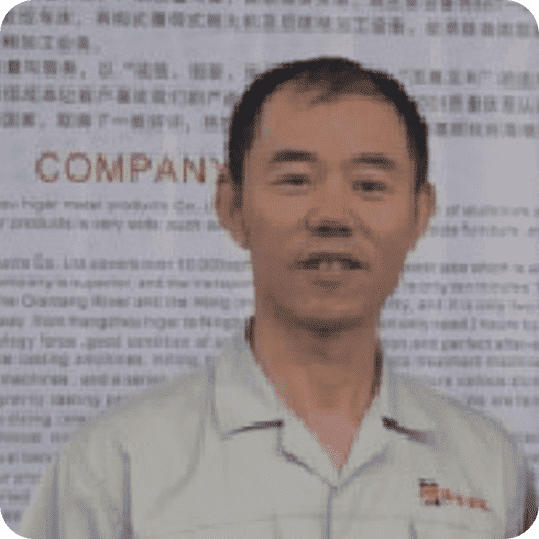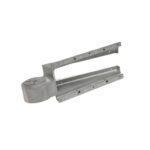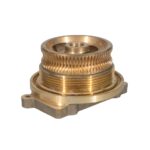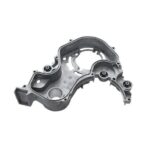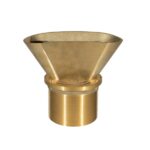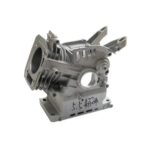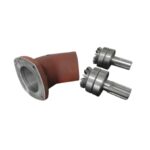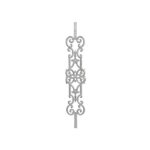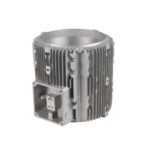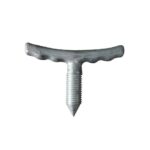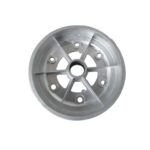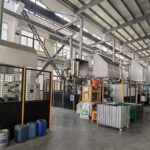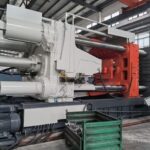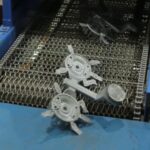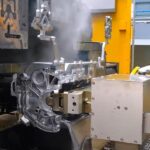Inclusions are non-metallic particles that get trapped in the molten aluminum and end up inside the casting. You can’t eliminate them completely, but you can keep them within a safe level by:
- Melting clean ingots and strictly controlling charge materials
- Skimming dross and slag thoroughly before every pour
- Using proper refining and degassing to remove oxide films and gas
- Designing smooth, well-balanced gating systems to avoid turbulence
- Using ceramic foam filters on critical parts
- Keeping ladles, tools, and furnaces clean and well maintained
- Monitoring metal and mold temperature and holding time
- Inspecting parts with visual inspection, X-ray, and/or metallographic checks where needed
At Yongzhu Casting we combine these process controls with clear inspection plans so buyers know exactly how inclusions are being kept under control.
What Are Inclusions in Die Casting?
In die casting, inclusions are unwanted non-metallic materials trapped in the metal during melting, handling, or filling of the die. Typical inclusions include:
- Oxide films on the aluminum surface
- Slag or dross from the furnace
- Broken refractory, sand grains, or core fragments
- Undissolved intermetallic compounds or “sludge” particles
These particles are usually harder and more brittle than the surrounding metal. They create stress concentrations, weaken the casting locally, and can ruin machining tools or surface finishes.
From a metallurgical point of view, we often divide inclusions into:
- Endogenous inclusions – formed inside the melt by chemical reactions (for example, oxide films generated when the metal surface reacts with oxygen).
- Exogenous inclusions – entering from outside the melt, such as broken refractory, sand, slag, or dirt dropping into the ladle.
For high-integrity aluminum die castings, the goal is not “zero inclusions” (which is almost impossible in mass production), but keeping their size, number, and location within acceptable limits.
How Are Inclusions Different from Other Die Casting Defects?
Inclusions are often confused with porosity or other defects. Understanding the difference helps with troubleshooting.
Inclusions vs. Gas or Shrinkage Porosity
- Inclusions
- Solid particles trapped in the metal
- On X-ray: appear as irregular dark spots or streaks with sharp boundaries
- On fracture surface: can see hard particles or stringers at the defect
- Gas porosity / shrinkage
- Voids filled with gas or vacuum
- On X-ray: round or smooth cavities with soft boundaries
- On fracture: open holes rather than solid contamination
Process countermeasures are also different: inclusions are controlled mainly by clean melt and flow, while porosity is controlled by venting, pressure, and solidification design.
Inclusions vs. Cold Shut or Misrun
Cold shut and misrun occur when two metal fronts fail to fuse or when the metal freezes before filling, leaving visible lines or unfilled areas. Inclusions may be present near these defects, but they are not the same issue. A casting can have acceptable filling yet still fail because of internal inclusions.
Common Types of Inclusions in Aluminum Die Castings
In aluminum die casting we typically encounter several families of inclusions. Below is a practical overview from a foundry perspective.
Oxide Film Inclusions (“Bifilms”)
When molten aluminum surface breaks and folds over itself under turbulence, a double-layered oxide film forms, often called a bifilm.
- Source:
- Free-fall pouring with splashing
- Poorly designed runners or ingates causing sharp turns and high velocity
- Stirring the melt too aggressively during transfer
- Appearance:
- On X-ray: thin, irregular, worm-like dark lines or curtains
- In section: thin, flaky discontinuities
- Effect:
- Severely reduces fatigue strength and pressure tightness
- Acts as crack starters under cyclic loading
Controlling oxide films is often the most important task for aluminum die casters.
Refractory and Slag Inclusions
Refractory inclusions come from broken or eroded furnace linings, ladles, launders, or flux residues. Slag or dross particles can also be entrained into the metal if skimming is poor.
- Source:
- Not skimming the furnace properly before tapping
- Scraping refractory surfaces with tools
- Damaged launders or ladles shedding particles
- Appearance:
- Hard, irregular particles; sometimes visible on machined surfaces
- Often concentrated near ingates or heavier sections
- Effect:
- Causes tool wear and chipping during machining
- Produces local hard spots and poor surface finish
Sand and Core Inclusions
If you also use sand cores or temporary molds for special features, sand inclusions become a risk.
- Source:
- Loose core sand washed into the metal stream
- Erosion of poorly compacted sand at the gate or runner
- Broken cores during handling or pouring
- Effect:
- Abrasive particles that rapidly wear cutting tools
- Rough surface pockets and potential leakage paths
Even in primarily die-cast production, sand or grit from shot-blasting media can occasionally be trapped in re-melted returns if they are not cleaned properly.
Intermetallic “Sludge” Inclusions
In aluminum alloys containing iron, manganese, and chromium, heavy intermetallic compounds can form when the metal stays too long at lower temperatures.
- Source:
- Long holding times at sub-optimal temperature
- Excess Fe or other heavy elements in the alloy
- Inadequate melt circulation at the bottom of the furnace
- Effect:
- Hard, needle-like particles that scratch machining tools
- Local brittle spots reducing ductility
Good alloy control and proper holding temperature help keep sludge under control.
Gas / Bubble Related Inclusions with Oxides
Sometimes gas bubbles trap oxide skins on their surface, forming a complex “gas + film” defect. These are often seen in pressure tight parts when degassing is poor. The remedy is a combination of degassing and flow control.
Effects of Inclusions on Die Cast Parts
Why are inclusions such a concern to design engineers and buyers?
Mechanical Strength and Fatigue
- Inclusions act as hard particles or cracks inside the metal.
- Under stress, they concentrate load on a very small area, which can lead to:
- Lower tensile and yield strength
- Reduced fatigue life, especially in components under cyclic loads
- Early leakage in pressure-bearing housings or valves
For steering, braking, or structural components, inclusions directly influence safety margins.
Machinability and Tool Life
- Refractory, slag, or sand particles are much harder than the aluminum matrix.
- They chip cutting edges, cause chatter, and produce inconsistent chip formation.
- Tooling costs rise, and dimensional stability becomes harder to control.
If a casting supplier is responsible for machining, they pay this cost. If machining is done by the buyer, inclusions turn into hidden scrap and extra tooling expense.
Surface Quality and Coating
Inclusions close to the surface can lead to:
- Pits and pull-outs after machining
- Pinholes or craters after anodizing, painting, or plating
- Poor cosmetic appearance in visible consumer parts
For decorative or sealing surfaces, good inclusion control is essential.
How to Inspect Die Castings for Inclusions
Depending on the application, different inspection methods are used to detect and evaluate inclusions.
Visual and Surface Inspection
- After shot-blasting and machining, operators check for unusual pits, streaks, or hard spots.
- Areas around ingates, thick sections, and weld repairs deserve special attention.
This method is inexpensive but only finds defects connected to the surface.
X-ray or CT Scanning
- Conventional X-ray is commonly used for safety-critical parts (e.g., steering housings, pressure die castings).
- Inclusions appear as irregular dark spots or lines. Experienced inspectors can distinguish them from porosity.
- CT scanning provides full 3D information, useful for development or failure analysis.
Buyers can specify X-ray levels (e.g., 100% inspection for certain features, or sampling according to a standard) in the control plan.
Metallographic Examination
For deeper understanding, test coupons or failed parts can be sectioned and examined under a microscope:
- Reveals inclusion type, size, and distribution
- Confirms whether defects are internal metallurgical issues or handling/cleanliness problems
- Often used for PPAP, APQP, or when qualifying a new supplier
Melt Quality Checks
Though more common in large foundries, some die casters monitor melt cleanliness using:
- Hydrogen content measurements (to control porosity risk)
- Analysis of filter residue or sampling coupons to see trapped particles
- Chemical analysis to keep Fe, Mn, and other elements within specified limits
At Yongzhu Casting we combine visual checks, process monitoring, and—where the application requires—X-ray and metallographic analysis agreed case-by-case with the buyer.
Process Controls to Prevent Inclusions in Aluminum Die Casting
Preventing inclusions is not a single action; it is a process control loop that covers melting, transfer, filling, and housekeeping. Below are key areas and typical actions.
Charge Materials and Melting Practice
- Use clean primary ingots and strictly control the proportion and quality of returns.
- Avoid painted, oily, or heavily contaminated scrap.
- Preheat returns and ingates to remove moisture and avoid explosions or spatter.
- Maintain proper furnace temperature and avoid long holding times that promote sludge.
Skimming and Furnace Cleaning
- Skim slag and dross from the furnace surface regularly, not only before pouring.
- Clean the furnace hearth and corners at defined intervals to prevent buildup.
- Use optimized fluxes where appropriate and remove them completely after treatment.
Refining and Degassing
- Use rotary degassing or inert gas lances to remove dissolved hydrogen and float oxides.
- Apply suitable fluxes to break oxide skins and allow them to float to the surface.
- Record treatment parameters (time, gas flow, temperature) for traceability.
This step reduces both porosity and oxide film inclusions.
Metal Transfer, Ladles, and Launders
- Keep ladles, launders, and pouring spouts preheated and free of old metal or slag.
- Minimize transfer height to avoid splashing and air entrainment.
- Use covers or lids to protect the metal surface during transfer.
- Replace worn refractory before it starts to flake or crack.
Gating and Runner Design
- Design runners to fill the cavity smoothly with controlled velocity.
- Avoid sharp 90° turns, sudden expansions, or dead zones where dross can accumulate.
- Position ingates to minimize free-fall and splashing.
- Verify the design using simulation or empirical rules and adjust after initial trials.
A well-designed gating system is one of the cheapest ways to reduce oxide inclusions.
Filtration and Flow Conditioning
For critical parts, ceramic foam filters or special flow control devices are strongly recommended.
- Filters trap slag, dross, and larger oxide clusters before the metal enters the die.
- They also calm the flow and reduce turbulence.
- Filter pore size (PPI) and placement are chosen according to alloy, production rate, and part size.
Die and Core Maintenance
- For any sand or salt cores used together with die casting, ensure high compaction and correct binder levels.
- Repair or replace worn cores and sleeves promptly so they do not shed material.
- Maintain good vent cleaning and die surface quality to avoid loose scale.
Shop Cleanliness and Handling
- Keep shot-blasting media, sand, and grinding dust away from charge material and ladles.
- Store returns in dedicated, clean bins (no mixing with floor sweepings).
- Train operators to avoid dropping tools, bolts, or scale into open ladles or furnaces.
Process Monitoring and Documentation
- Set up control charts for metal temperature, holding time, flux usage, and degassing parameters.
- Record furnace cleaning, filter changes, and major maintenance events.
- Link casting rejects to specific heats or batches so root causes can be corrected quickly.
At Yongzhu Casting we use this kind of documented process control so buyers can audit how inclusions are prevented, not only how defects are detected.
Buyer Checklist: Questions to Ask Your Die Casting Supplier
If you are sourcing aluminum die castings and want reassurance about inclusion control, consider asking:
- What is your standard practice for melt treatment and degassing?
- Do you record treatment time, gas flow, and temperature?
- How do you skim and clean the furnace, ladles, and launders?
- How often is the furnace fully cleaned?
- Do you use ceramic foam filters or other filtration on critical parts?
- For which components and why?
- What inspection methods do you apply for inclusions?
- Any X-ray, CT, or metallographic checks? What standards or acceptance criteria are used?
- How do you trace back a defect to the melting batch?
- Do you have heat-number or lot-number traceability?
- Can you share examples of past corrective actions related to inclusions?
- This shows real experience solving such problems.
A professional supplier should be able to answer these questions clearly and provide sample records when needed.
FAQ on Inclusions in Die Casting
Q1. What is the main cause of inclusions in aluminum die casting?
The main causes are dirty melt and turbulent metal flow. If slag, dross, or oxide films are not removed from the furnace and the metal is poured with splashing or long free-fall, they are easily carried into the cavity and frozen inside the casting.
Q2. How can you tell inclusions from porosity on X-ray?
Inclusions tend to appear as irregular dark streaks or spots with sharp edges, sometimes oriented along the metal flow direction. Gas porosity is more rounded and uniform. Experienced inspectors also compare the defect’s location with the gating layout to judge whether it is flow-related or shrinkage-related.
Q3. Are all inclusions unacceptable in die cast parts?
In practice, a very small amount of fine inclusions is unavoidable and can still meet strength and fatigue requirements. Most standards define acceptable levels based on size, number, and location. Critical areas (such as sealing surfaces or highly loaded sections) are judged more strictly.
Q4. Do ceramic filters completely remove inclusions?
Filters are very effective for large slag and dross particles and help calm the flow, but they cannot remove every tiny oxide film. They must be combined with good melting, skimming, and gating practice.
Q5. Can heat treatment remove inclusions that are already inside the casting?
No. Heat treatment can change the matrix properties but will not dissolve oxide films or sand grains. Once a large inclusion is trapped, the only reliable remedy is to scrap the part or, in some limited cases, to machine it away if it is not in a critical area.
Q6. When should a buyer require X-ray inspection for inclusions?
X-ray is recommended for pressure-tight components, safety-critical automotive parts, or any application where unexpected cracking or leakage would be dangerous. For simple non-critical housings, visual inspection and process control may be sufficient.
Conclusion
Inclusions in die casting are one of the most common and critical defects in aluminum parts. They arise from dirty melt, worn refractory, sand or slag, and turbulent flow conditions. Although they cannot be eliminated completely, they can be controlled through:
- Clean charge materials and disciplined furnace practice
- Effective degassing and dross removal
- Well-designed gating, filtration, and transfer systems
- Regular inspection and documented process control
At Yongzhu Casting we have been producing aluminum die castings since 2004.
For projects that are sensitive to inclusions, we combine strict melt treatment, ceramic filtration and documented inspection plans to keep defects within safe limits.
With our 280–2000 ton machines we supply brackets, housings and structural parts for automotive, energy, lighting and industrial equipment.
If you’d like to review a drawing that is sensitive to inclusions, our engineers can help you define a practical control and inspection plan.
Why buyers work with Yongzhu Casting
- Clean melting and rotary degassing with recorded parameters
- Ceramic foam filters on critical parts
- Optional X-ray and metallographic checks agreed in the control plan
- Flexible batch sizes, from samples to mass production
- Fast DFM feedback and quoting support
Send us your drawing and expected annual volume and we’ll get back to you with a proposal within 24 hours. 🔜🔜🔜 yongzhucasting@gmail.com

